Radio Control Club of Detroit & EAA Joint Fly-In
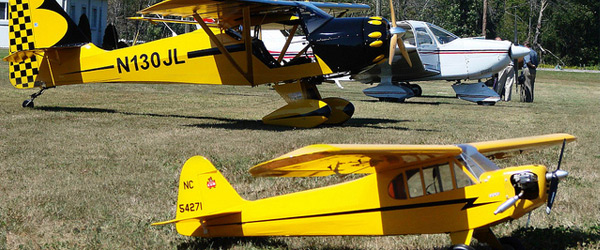
A collaborative article by Lou Tisch, Noel Hunt & Rex Phelps ModelAviation.com online exclusive feature.
Speeding down the grass runway at David’s Landing, with Steve Green at the controls, nearing take-off speed, I realized that I’ve again put my life in the hands of a fella I just met 10 minutes ago. Okay, I’m fine with that; let’s get into the air.
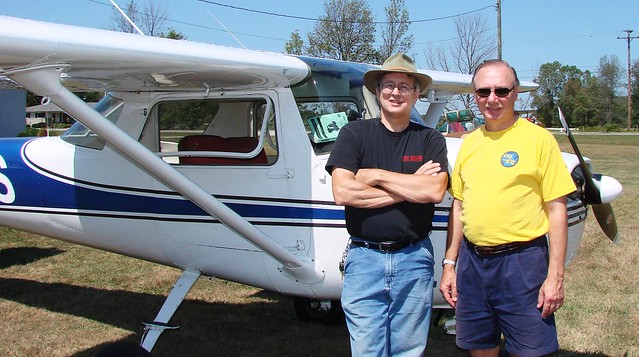
I’ve always loved take-offs and landings and there is nothing more exciting than that activity in a small, private, two-seater, such as the Cessna 150. Prior to getting into the 150, I did do a quick “once over” of the plane and was impressed with the way Steve maintains his airframe and the motor sounded very smooth as well upon start up so, I was quite comfortable and ready to enjoy the ride. Of course, “would you like to fly it” always brings a bit of adrenaline up from the depths
Steve asked me if I knew what a VOR was. Of course, I had to plead ignorance. He said, “Well, I’ll show you.” That led to a swing up west of Port Huron to one of the VOR transponder/signal units that give you navigation points that can get you around this country without the use of a GPS. A nice fact to have in your back pocket in case other means of navigation are “out.”
After passing over the VOR point and seeing the indicator switch from “TO” over to “FROM,” I really realized how well-developed and important this entire navigation system is.
Heading back toward Port Huron, we dropped into the airport there to top off the fuel tanks. Wow, another landing and takeoff to savor. It’s interesting the safety precautions observed during fueling. The Cessna 150 was parked well away from the hangar and other aircraft, and the fuel truck came to the plane. Once grounding was secured, the tanks were topped off and then Steve checked the fuel to make sure there was no water introduced into the tanks. Safety first, very cool.
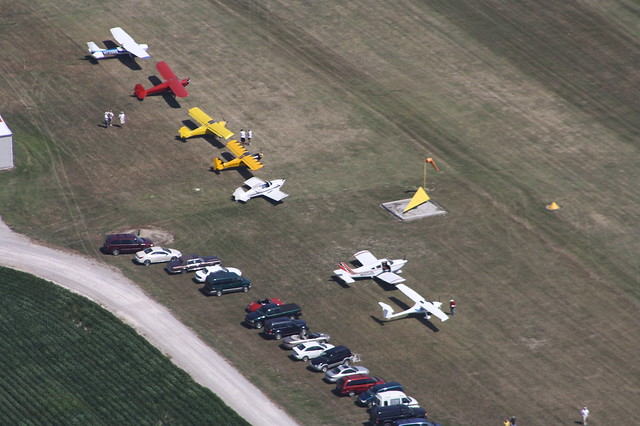
About an hour and a half after initial takeoff, we dropped back into David’s Landing and another “ride of my life” was in my record books. Ya know, I gotta get me one of those flying machines. I’ve been building and flying model airplanes since I was three years old and have always dreamed of a full-scale one of my own. I’ll have to look closer into the EAA and the Chapter 13 Club and its programs.

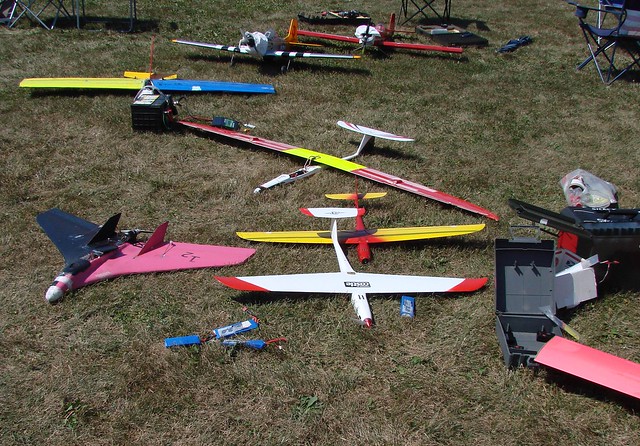
The time had come to get some of my models into the air and enjoy the rest of the festivities. We had more RC modelers taking full-scale rides and full-scale pilots putting in some RC flight time with an instructor and a buddy box. There was plenty of both to go around, ranging from combat ships and trainers, through sailplanes, pattern, biplanes, Big Birds, and scale. There was even an RV-6 model to challenge the full-scale RV-6 that performed so well, owned by Dugdale.

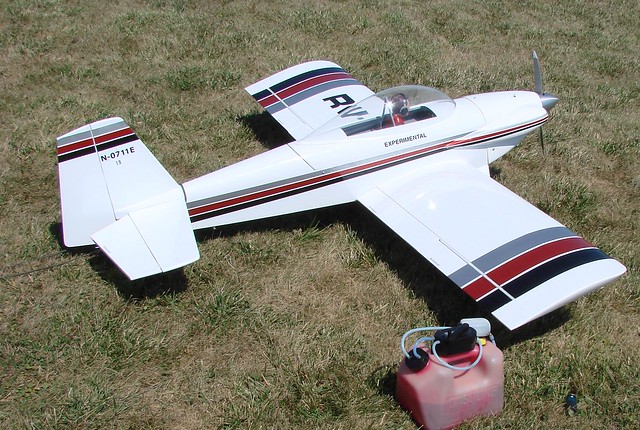
This second annual EAA Chapter 13/ Radio Control Club of Detroit (RCCD) joint fly-in occurred at the end of August, 2010. Just how did this event come to be? Rex Phelps and Noel Hunt are two friends with a mutual, if slightly different, interest in aviation. Rex is the Chapter 13 president of the EAA, while Noel is the vice president of the RCCD, a member club of the AMA. The home flying fields of the two clubs in Southeast Michigan are just a few miles apart.

Sometime in the winter of 2008/2009, the two friends posed an interesting question: Would members of their respective clubs have an interest in each others’ flying activities? Each had appeared as a guest speaker at a meeting of the other’s club, but felt there was an opportunity to share more. A joint fly-in seemed like a possibility.
From the seed of an idea, individual elements grew to become a proposed format. Full-scale pilots would fly RC planes with RC instructors and RC pilots would go for short rides in EAA planes and RC demo and general RC flying would be laid onto that framework. Pilots of both model and full-scale planes would be available to chat about the objects of their pride and a barbecue lunch would provide additional time to share aviation conversation.
Next, the level of interest was polled at club meetings: There seemed to be enough interest on both sides to proceed.
Where to hold such an event? Dave Shirey, a member of Chapter 13, is the owner of David’s Landing, a public-use airport (5Y5) and was most agreeable to hosting the fly-in, provided it was held after the soft spring ground had hardened. This led to timing of the first weekend in June.
In the weeks before the fly-in there was considerable discussion about safety. A set of flight rules was established that would ensure that RC aircraft were securely grounded during the takeoff or landing of all full-scale planes, and pilots of the “big boys” would verify by radio with the flight boss that the air strip was clear before commencing any takeoffs or landings.
A casual survey of members the evening before the event revealed a major issue: there were far more people intending on participating than Rex and Noel had anticipated. Dave’s septic tank might be overwhelmed. Additional restroom facilities were needed. Finding a “porta-potty” at 8 p.m. on a Friday night seemed impossible, but the resourcefulness of club members, not to mention the great service RCCD gets from Pot O’ Gold, saw the welcome yellow structure in place the next morning.
The first joint fly-in was a great success and even as the RC planes were being loaded back into vehicles, canopies, tables and chairs stowed, and pilots getting ready to fly their planes to their respective base airports, questions were being asked about the next joint fly-in. Those questions were in fact an answer to the original question: “Would members of their respective clubs have an interest in each others’ flying activities?” The answer was a convincing YES! (It appears that the leaders of the two respective national organizations have come to the same conclusion.)
And so, the second annual EAA Chapter 13/RCCD join fly-in made it on to the 2010 calendar for both clubs. The June date was rained out, resulting in postponement until August. The format of the second event followed the first closely, with minor improvements learned from experience. Members of both clubs began arriving at David’s Landing around 9 a.m., either flying or driving in and soon a “settlement” of pop-up canopies, camp chairs, RC pits, and full-scale aircraft parking was visible from the air for the arriving pilots.
As probably occurs anytime pilots gather, landings are assessed with critical eyes. There were murmurs of appreciation when a 1947 Luscombe performed a beautiful sideslip over the trees and road to the north of the strip, straightening out just in time for a feather-light touchdown in front of the “gallery.” “That’s Bob Mahieu,” someone said. That’s a very cool approach to watch and a real ordeal when in the passenger seat.
After a short pilots’ briefing to reinforce the safety precautions, Bob was the first brave pilot to try flying without the benefit of seat-of-the-pants feel. Noel took an RC trainer to a safe altitude before depressing a switch on his instructor’s transmitter giving control to Bob’s student transmitter—the buddy box. Accompanied by many “helpful” comments from his fellow Chapter 13 friends, Bob did some pretty fancy aerobatics ... even though he was attempting to fly a smooth oval pattern! Anytime the ground seemed to be pulling too strongly, Noel would release the switch and get the plane out of the strong gravitational attraction. Back at a safe altitude, control was passed back to Bob. Soon, the smooth ovals became recognizable and Noel then guided Bob through basic, intentional loops and rolls.
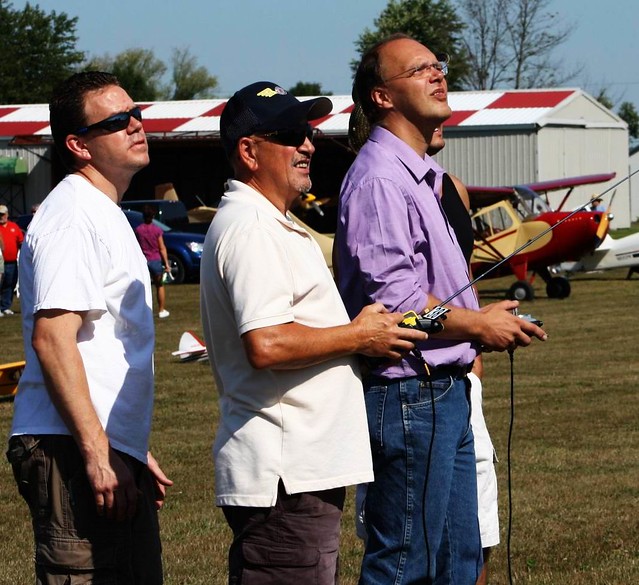
The RC instructors were kept busy the rest of the day with buddy-box flights. Full-scale pilots get the hang of RC flying so much quicker than true rookies since they already understand the principles of flight. The only tough things to overcome are having no “feel” of the plane, and the apparent reversal of roll and yaw controls when the plane is approaching. Most were able to achieve controlled flight in an oval pattern and basic loops and rolls by the end of their first flight.
After his RC flight, Bob then started his other role of the day, taking RC pilots for rides in his Luscombe. Every one of them eagerly agreed to return to the field with a sideslip. The other Chapter 13 pilots also began providing rides to RCCD members. The planes included two Kitfoxes of Rex Phelps and Mike Fisher; Peter Dugdale’s RV-6; 150 and 172 Cessnas belonging to Mike Grass, Steve Green and Laurelle White; Doug Conciatu’s Champ; Bob’s Luscombe; and Dave Shirey’s Varga.
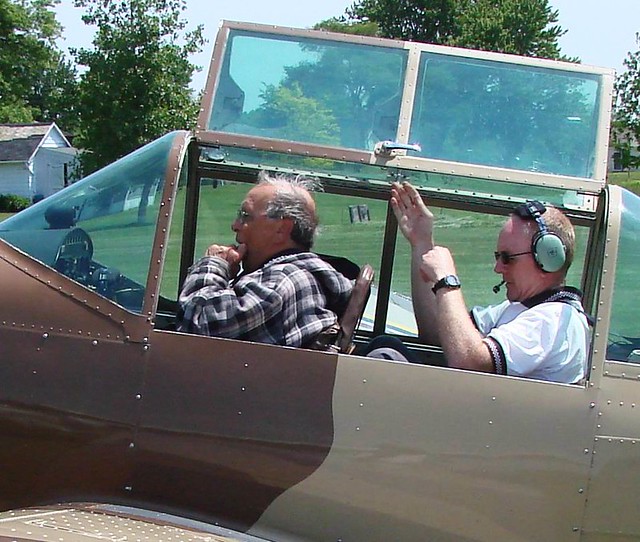
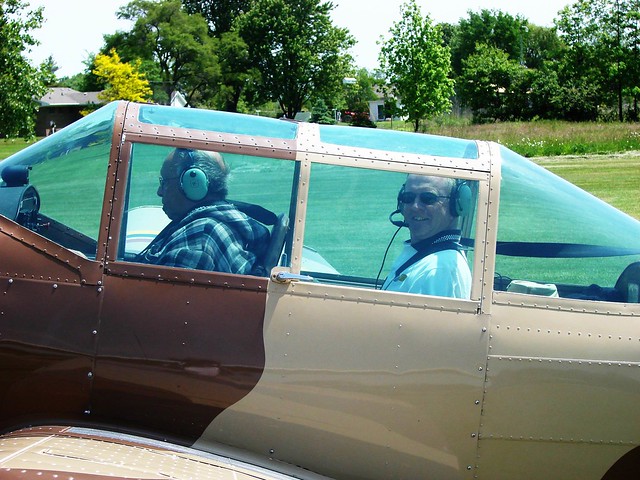

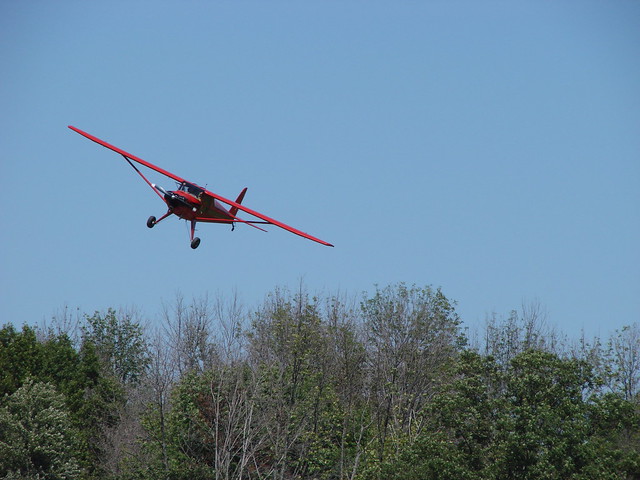
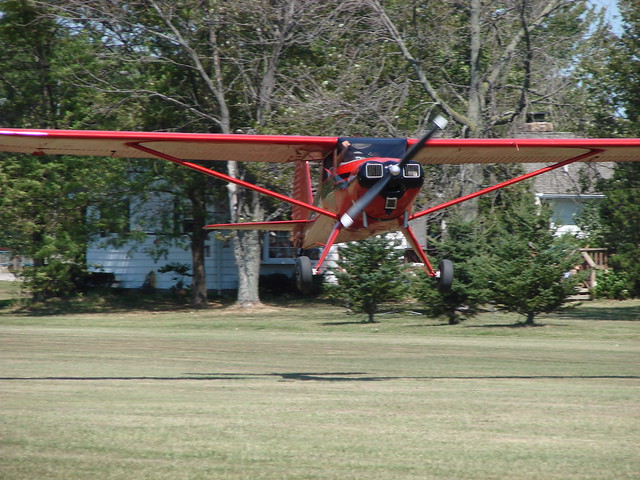
Dave also flew a quick solo circuit in his recently completed Fisher Celebrity Bipe. Some planes, both full-scale and model were at the field, but did not participate in the flying. Pilots only flew if they felt comfortable doing so and no one was pressured to fly. Naturally all were happy to discuss their aircraft as groups clustered around them throughout the day.
A common perception developed among the RC pilots was that the Chapter 13 pilots don’t know how to fly their airplanes, they only know how to take off and land. This perception developed because as soon as a plane was safely off the runway, they’d say “you take it.” That often lasted until it was again time to return to the airfield! Just kidding of course!
The very well-executed landings only emphasized the flying skills that the pilots possess. The RC pilots certainly enjoyed piloting the plane they were flying and looking down at the ground, rather than watching from the ground.
The flight boss role was shared by a few guys and they were busy. However, both sets of pilots were disciplined and there were no incidents or even close calls. If the engine of a full-scale aircraft was heard starting or if a plane was seen flying a crosswind entry at 1,000-foot AGL over the field, the flight boss would call “full size” and any RC planes currently in the air would land, taxi off the airstrip and be shut down. Radio communication was used for confirmation.
Punctuated between the rides and buddy-box flying, were RC demonstrations. RCCD’s formidable combat pilots Don Veres II, Keith Jones, and “Team Gilkey” (Scott, Brian, and Erik), provided thrills and spills with a few heats of 1/2A Combat. In addition to the streamer cutting, there were the inevitable midair hard contacts and downed combatants. Brian also flew some electric-powered “hotliners” at speeds in excess of 150 mph, demonstrating the reflexes and depth perception of the young.
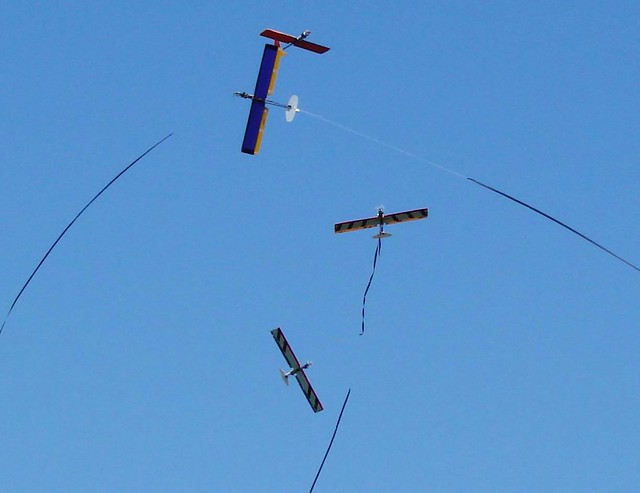
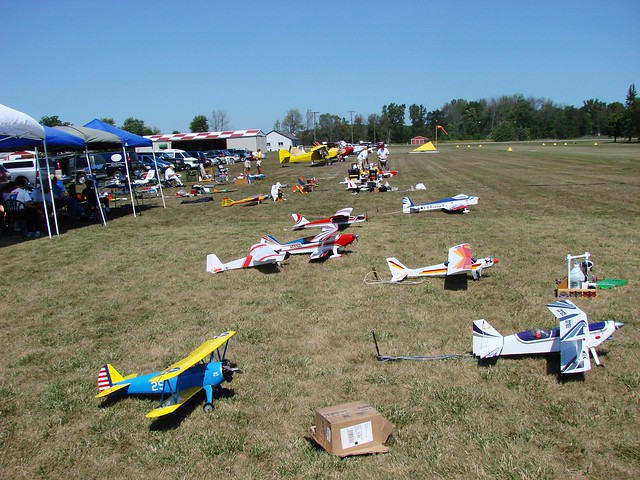
Noel put his Super Skybolt biplane through some precision aerobatics and there was also some general RC sport flying.
Around midday people began drifting toward the barbecue setup in Dave’s garage, then with loaded plates in hand, groups gathered in the shade of the canopies where the food was seasoned with aviation conversation.
Flying resumed after lunch and by the time things started to wind down, roughly 20 people had flown on the RC buddy box, and almost 30 had gone for a ride in a full-scale airplane. There were some who elected not to fly, but no one was turned down.
As one might expect, most full-scale pilots have at least “some” RC experience already. Conversely, most of the RC pilots have also flown in general aviation aircraft. On this day, everybody got to expand their experiences in a fun and relaxed atmosphere. Spectators on the ground got an eyeful as RC guys put a variety of aircraft in the air while airplanes with two people on board were up poking holes in the sky. The timing of events was well organized to keep all planes well separated. Safety at the event was the highest priority.
Rex Phelps’ last flight of the day was quite memorable. Willie McMath and Rex had tried unsuccessfully to fly last year, but ran out of time. They made it a high priority to make sure it happened this year. It finally did.
For those of you who happen to know Willie, you would have loved to see how he came out of his shell! He explained that he’s a very shy and quiet fellow, but once the opportunity to get in the right seat arose, he was unflappable! The RC Combat planes were in the air and looking to Rex like a ballroom brawl taking place in a broom closet. Willie talked to him through the headsets as they waited in Rex’s Kitfox for clearance. Willie told Rex all about the ribbon cutting “ceremony” going on out there as he went through his checklist for their flight.
Anybody watching the two of them sitting in a 39-inch-wide cabin with Willie’s arms flailing around, had quite a sight.
Finally, it was Rex and Willie’s turn. There was no apprehension on Willie’s part, just anxiousness to get airborne. As Rex pushed the throttle forward, Willie was one big smile. Once a safe altitude was reached, Rex gave him the controls and sat back to enjoy the ride. It was obvious that Willie knew how to fly. He did mention that he’d done some full-scale flying before, but not enough to get his license.
The Kitfox’ doors hinge at the top. One of the many nice features of the plane is the ability to open the doors while flying. When Rex mentioned this to Willie, there was no hesitation. Once he checked the opening procedures with Rex, that big smile got even larger. Soon, they were doing open cockpit flying. Finally, they headed back to David’s Landing, enjoying the warm breeze all the way back. Rex imagined that Willie could have landed the Kitfox just fine but he took the controls on the base leg just before turning final. Rex figured that he needed the practice.

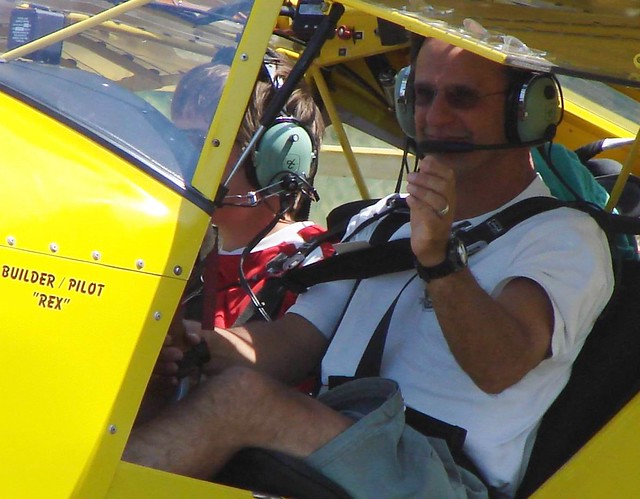
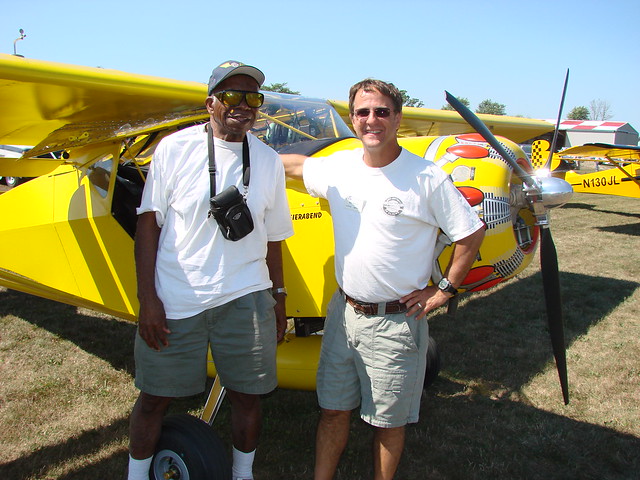
Willie was all smiles for the rest of the day too. If you beg him, he might be willing to show you a picture he took of the two of them while they were flying. It was on the flight that he learned that skill. If you see the picture, there’s no question as to whether or not he’ll want to come back next year!
Judging by “when’s the next joint fly-in?” questions heard again this year, it looks as though the EAA Chapter 13/RCCD joint fly-in will be a regular calendar fixture for both clubs.
Special thanks to Noel Hunt and Rex Phelps for their organization, to Dave Shirey for his outstanding hospitality and runway, and to all who participated, making it a great time. See you next year. Thanks all!
 Lou Tisch (editor)
Photography by Lou Tisch and Norm Zielinski
Lou Tisch (editor)
Photography by Lou Tisch and Norm Zielinski
Commentary: As a result of their friendship over the past couple of years, Noel has joined the EAA, and attended his first Oshkosh AirVenture in 2010. Rex has begun accumulating what is needed for his first RC aircraft. Safety Check List: Prior to Event: • Obtain AMA insurance prior to event (non-chartered flying site, form 305) • Check for other RC clubs within 3-mile radius. Establish frequency management agreement for the day if any such clubs exist. • Event coordinators from both clubs visit the flying site together to understand the layout. At Start of Event: • Establish separate areas for full-scale and RC planes to park. • Establish a designated RC flightline (edge of runway). • Establish RC pilot flying stations on that line (maximum 4). • Establish RC flight area (never over people, vehicles, planes, or buildings). • Establish RC pit area for engine starting, between people area and flightline. • Establish a people area for shade canopies, chairs, vehicle parking, etc. • Provide frequency control and wind-proof pin board. • Conduct safety briefing prior to start of activities. Both sets of pilots present. During Event: • Designate one “Ground Controller” at all times. He/she is the boss. No questions! • Ground Controller has hand-held ground-to-air radio. • Each RC pilot must have a spotter. A “student” is not a spotter. • No maiden flights. • Pilots of full-scale aircraft will announce arrival either by radio, or by flying a ‘crosswind’ entry at 1,000 feet AGL over the field and confirm by radio that the runway is clear, prior to turning onto final. • Pilots of full-scale aircraft will confirm by radio that the runway is clear, prior to take-off. • During full-scale aircraft taking off or landing, all RC aircraft will land and/or remain on the ground, engines off, and secured if electric powered. • When pilots of full-scale aircraft announce takeoff or landing, the Ground Controller will loudly instruct RC pilots to land their planes and confirm they heard.
View the entire photo collection from the event.










1 comments
RCCD/EAA Flyin
Add new comment